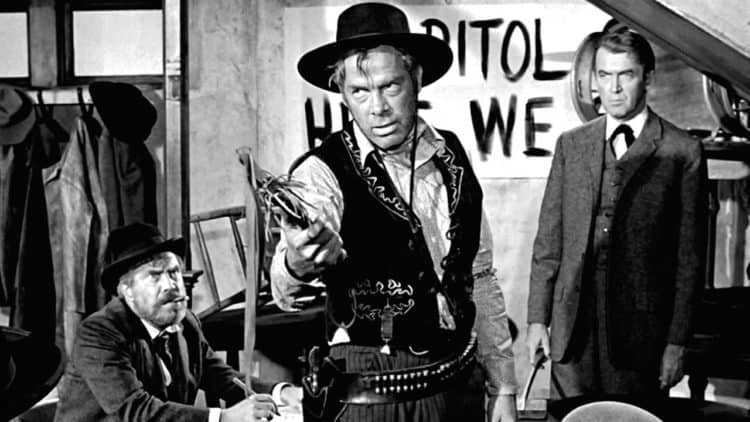
Of his record four Academy Awards for Best Director, not a one was won for the genre he unmistakably revolutionized. John Ford was the wunderkind of the Western, and according to the man himself, he made his last great one in 1962. The Man Who Shot Liberty Valance is a masterwork retaining wall in a career bathed in genius and serves as Ford’s final collaboration with John Wayne as The Cowboy he helped to craft. More importantly, the film provides the soundtrack for Ford’s Western swansong while illuminating the death of the west itself as a “deeply personal farewell to a period in American history he loved, a folklore he helped create” (Hunter).
“It’s his last word on the west” says Peter Bogdanovich, Ford protégé and a legendary director in his own right. The Man Who Shot Liberty Valance is a film steeped in the dealings of honor, cowardice, love, and integrity while simultaneously illustrating the advancement of society, both actual and cinematic. It is also “a haunted film. Haunted by the past, says critic Richard Schickel” (Schoenberger). This past is one that Ford generated as truth, and is now slipping into legend. The underlying theme of Liberty Valance is progress as America and represents the classic example of “the successive stages of western development from a wilderness into a garden” (Belton).
Progress is the American heartbeat and perhaps no film genre is a better vehicle for that reality than the Western. In Liberty Valance, this sentiment is summed up neatly approximately nine minutes into the picture. Hallie, who is played by the “consistently effective” (Variety) Vera Miles, sits in a bare buckboard on a familiar street looking around her somehow foreign hometown. She looks upon the town of Shinbone for the first time in 25 years, comprehending that “almost no traces of the old Shinbone can be found” (Hunter). Emanating an expression that longs for yesteryear, the camera cuts to a medium shot as she remarks, “The place has sure changed”. As a slow zoom is initiated to indicate a moment of nostalgic reflection, former Marshal Link Appleyard (seated next to Hallie) responds, “The railroad done that. Desert’s still the same”. The mise-en-scène is used beautifully in this scene providing a dynamic contrast in period costume from the well-dressed Hallie, who made it out of Shinbone and thus representing progress, and the shabbily dressed Link who remained in the town, the unchanged “Link” to the old days. By showing Link’s plight, progress is shown as a necessary agent of destruction for the frontier while reminding the audience to not “forget the people ‘progress’ plows right over” (Soderberg).
The most notable element of the mise-en-scène in this sequence is the train whistle that howls in the background. This is a classic element of the Western genre encompassing “the Western’s ambivalent attitude toward progress in general and toward trains in particular” (Belton). This scene encapsulates the essence of the “new(er) west” (Belton) replacing the “old(er) west” (Belton). Hallie and Link then abscond in the horse drawn buckboard en route to a location outside of town. A cut to a long shot of the now cosmopolitan Shinbone main street envelopes the screen where elements of Ford’s exceptional mastery of the mise-en-scène once again emphasize that this old west town has fallen victim to America as progress by showing concrete sidewalks and telephone poles. The long shot fades out just as the two principles pass under the power lines that now hang over the town’s main thoroughfare.
As the title suggests, Ford’s masterpiece is a film that deals with life and death but the infamous “shooting” does not enter into the equation. The frontier is the victim with the film acting as a chronicle of progress providing the death nail. The result is a “sad but inevitable transition from an old social order to modern society as we know it today” (Hunter). The tragedy, translated by Ford through Hallie, is that the instrument of progress is also inevitably the victim of it.
At the time of filming Liberty Valance, John Ford was 67 years old; he had been making movies in Hollywood for 45 years. After a career beginning in 1917 that helped established the very foundation of the cinematic industry, Ford recognized the shifting winds of the mass predilection. By 1962, as Ford’s own horizon becomes imminently more valid, he delivers his final brilliant work. The Man Who Shot Liberty Valance “is unmistakably the director’s final statement on the West. In it, Ford gives us a capsule version of the world it took him 40 years to create, and then shows us how it died” (Hunter). The most oft quote from the picture is “This is the West, sir. When the legend becomes fact, print the legend.” That is the line that fans recall but what should be remembered is that the West now only exists in legend as “Ford bitterly laments the intrusion of reality on his legend” (Hunter). At the film’s conclusion aboard the train out of town, prideful Hallie states “This country used to be a wilderness. Now it’s a garden.” Hallie is certainly proud that her hometown has been developed from a wilderness into a garden but somewhere in her heart, like Ford, she is happy that not everything of her roots has been enveloped by progress. Desert’s still the same.
Works Cited:
- Belton, J. American Cinema/American Culture. New York: McGraw-Hill, 2013. 255. Print.
- Hunter, T. (March 18, 1967). The Man Who Shot Liberty Valance at The Harvard Square Theater. Retrieved September 24, 2018
- Schoenberger, N. (October 24, 2017). Wayne and Ford: The Films, the Friendship, and the Forging of an American Hero. Retrieved February 19, 2019
- Soderberg, B. (April 8, 2015). Subversive Western ‘The Man Who Shot Liberty Valance’ at the Senator. Retrieved September 24, 2018
- Variety (December 31, 1961). Film Review: The Man Who Shot Liberty Valance. Retrieved September 22, 2018
 Follow Us
Follow Us





